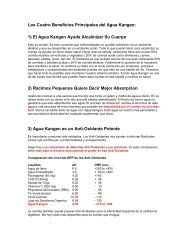ACID-ALKALINE BALANCE: ROLE IN CHRONIC ... - My Kangen Tools
ACID-ALKALINE BALANCE: ROLE IN CHRONIC ... - My Kangen Tools
ACID-ALKALINE BALANCE: ROLE IN CHRONIC ... - My Kangen Tools
You also want an ePaper? Increase the reach of your titles
YUMPU automatically turns print PDFs into web optimized ePapers that Google loves.
Y.-R. Huang et al. / Food Control 19 (2008) 329–345 335<br />
iting, and diarrhea (Archer & Young, 1988; Garthright,<br />
Archer, & Kvenberg, 1988). Although EO water has been<br />
proved to be effective against Staphylococcus aureus, trace<br />
amounts of enterotoxin produced by the bacteria may<br />
remain active after disinfection. Suzuki, Itakura, Watanabe,<br />
and Ohta (2002a) reported that exposure of 70 ng, or<br />
2.6 pmol, of staphylococcal enterotoxin A (SEA) in 25lL<br />
of phosphate buffer saline (PBS) to a 10-fold volume of<br />
EO water, or 64.6 · 10 3 -fold molar excess of HOCl in EO<br />
water, caused a loss of immuno-reactivity between SEA<br />
and a specific anti-SEA antibody. Native PAGE indicated<br />
that EO water caused fragmentation of SEA, and amino<br />
acid analysis indicated a loss in amino acid content, in particular<br />
Met, Tyr, Ile, Asn, and Asp. EO water denatures<br />
SEA through an oxidative reaction caused by OH radicals<br />
and reactive chlorine. Thus, EO water might be useful as a<br />
preventive measure against food-borne disease caused by<br />
SEA.<br />
Suzuki et al. (2002b) also reported that EO water could<br />
sterilize Aspergillus parasiticus and eliminate the mutagenicity<br />
of aflatoxin AFB 1 by the OH radical originating<br />
from HOCl. Exposing A. parasiticus at an initial density<br />
of 10 3 spores in 10lL to a 50-fold volume (500lL) of<br />
EO water containing 390lmol HOCl for 15 min at room<br />
temperature resulted in a complete inhibition of fungal<br />
growth. Three nanomoles of AFB 1 showed a high mutagenicity<br />
for both Salmonella Typhimurium TA98 and TA100<br />
strains, but this mutagenicity was reduced markedly after<br />
exposure to 20-fold molar amount of HOCl in the EO<br />
water in both TA98 and TA100. However, foods contain<br />
compounds such as proteins, lipids, vitamins, minerals,<br />
color, etc., and concerning food soundness, it may not necessarily<br />
be appropriate to apply EO water to wash food<br />
materials.<br />
8. EO water used as a disinfectant in the food industry<br />
8.1. Use of EO water for food processing equipment<br />
EO water has been used as a disinfectant for food processing<br />
equipment (Table 2). Venkitanarayanan et al.<br />
(1999a) reported EO water could be used as an effective<br />
method for eliminating food-borne pathogens on cutting<br />
boards. EO water (pH of 2.53, ORP of 1178 mV and chlorine<br />
of 53 mg/L) could also reduce Enterobacter aerogenes<br />
and S. aureus on glass, stainless, steel, glazed ceramic tile,<br />
unglazed ceramic tile and vitreous china surfaces. Immersion<br />
of these surfaces in EO water for 5 min with agitation<br />
(50 rpm) reduced populations of E. aerogenes and S. aureus<br />
on the tested surfaces to



